
Creating your own Rocket Industrial personal account has many benefits:

The Green Bay Botanical Garden, in conjunction with Washed Ashore: Art to Save the Sea , currently has on display eight larger-than-life sea animal sculptures that were created from ocean debris. This exhibit shows the effects plastic pollution has on bodies of water while educating viewers on ways to reduce their plastic waste.
Since 2010, Washed Ashore has cleaned more than 300 miles of beaches and processed more than 40,000 pounds of marine debris to create 70 larger-than-life sculptures. To create the sculptures, more than 14,000 volunteers have spent over 20,000 hours collecting plastics from bodies of water.
Eight sculptures are currently on display at the Green Bay Botanical Garden, each made from hundreds to thousands of pieces of ocean plastics. Learn more about each sculpture below:



Stanley the Sturgeon – The star of the show, Stanley the Sturgeon represents the plastic pollution that affects the Great Lakes, a region that supports upwards of 40 million people with its freshwater. Some of the most surprising items that made up Stanley were old cell phones, bike pedals, and flashlights
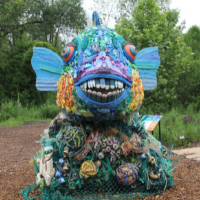


Priscilla the Parrot Fish – Priscilla, made from a bowling pin, toothbrushes, and fishing lures, highlights the importance of coral reefs and their endangerment because of marine debris and pollution.
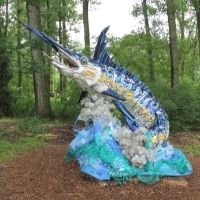


Flash the Blue Marlin – As blue marlins swim through the open ocean, they pass through waters overwhelmed with plastic pollution, including sunglasses, water bottles, and fishing poles.
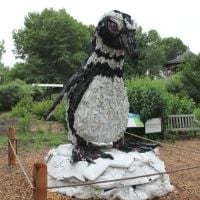


Gertrude the Penguin – Oil pollution continues to be the main threat to Magellanic penguins, like Gertrude, who lives on South American islands. Gertrude is composed of cooler lids, shoes, dry erase markers, and lighters, most of which are made from petroleum.
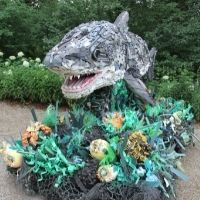


Chompers the Shark – As a vital part of ocean ecosystems, sharks eat turtles, seals, birds, and other animals but have also been found with tires, license plates, and plastic debris, like boogie boards, bottle caps, and flip flops, in their stomachs.



Giacometti the River Otter – North American River otters were threatened by trapping and habitat loss in the early 1900s. Since their restoration, it is important to keep their food sources and waterways free of harmful plastic debris, such as the wheels, duck decoys, and shotgun shell wads that Giacometti is made of.
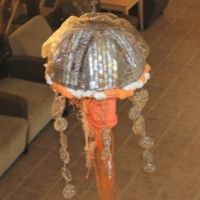


Sea Jelly Bloom – To sea turtles and other sea life, plastic shopping bags look very similar to jellyfish. Constructed from lighters, beach toys, and nets, this jelly bloom depicts the harm of plastic ingestion for marine animals.



“American” Sea Star – To bring attention to plastics used in Independence Day celebrations, this sea star features plastics that came from fireworks, water bottles, and plastic cups.
As a way to bring awareness to the harmful effects of plastic pollution, the exhibit shared various ways for the local community to make a difference. Swapping out everyday products like plastic wrap with beeswax wrap or bringing a reusable bag to the store reduces plastic waste. Cleaning up all trash when leaving a beach or boat is also important to ensure these items do not end up in bodies of water.
Rocket Industrial's passion for sustainability extends across the entire supply chain. We can help you reduce plastic waste by incorporating ecologically friendly materials, processes, engineering, and design into your packaging. Contact one of our packaging experts to get started and join us in removing packaging waste.